Arto Hellas
How Large Language Models Are Changing MOOC Essay Answers: A Comparison of Pre- and Post-LLM Responses
Apr 17, 2025Abstract:The release of ChatGPT in late 2022 caused a flurry of activity and concern in the academic and educational communities. Some see the tool's ability to generate human-like text that passes at least cursory inspections for factual accuracy ``often enough'' a golden age of information retrieval and computer-assisted learning. Some, on the other hand, worry the tool may lead to unprecedented levels of academic dishonesty and cheating. In this work, we quantify some of the effects of the emergence of Large Language Models (LLMs) on online education by analyzing a multi-year dataset of student essay responses from a free university-level MOOC on AI ethics. Our dataset includes essays submitted both before and after ChatGPT's release. We find that the launch of ChatGPT coincided with significant changes in both the length and style of student essays, mirroring observations in other contexts such as academic publishing. We also observe -- as expected based on related public discourse -- changes in prevalence of key content words related to AI and LLMs, but not necessarily the general themes or topics discussed in the student essays as identified through (dynamic) topic modeling.
On the Opportunities of Large Language Models for Programming Process Data
Nov 01, 2024
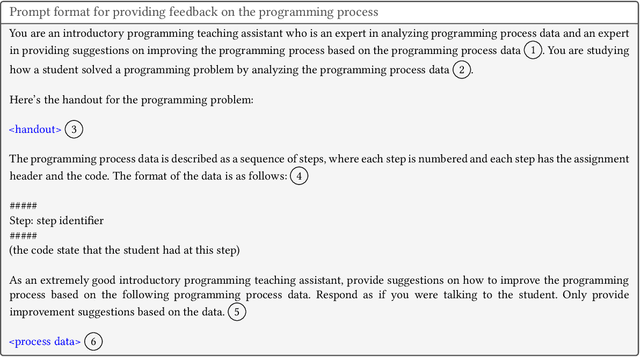


Abstract:Computing educators and researchers have used programming process data to understand how programs are constructed and what sorts of problems students struggle with. Although such data shows promise for using it for feedback, fully automated programming process feedback systems have still been an under-explored area. The recent emergence of large language models (LLMs) have yielded additional opportunities for researchers in a wide variety of fields. LLMs are efficient at transforming content from one format to another, leveraging the body of knowledge they have been trained with in the process. In this article, we discuss opportunities of using LLMs for analyzing programming process data. To complement our discussion, we outline a case study where we have leveraged LLMs for automatically summarizing the programming process and for creating formative feedback on the programming process. Overall, our discussion and findings highlight that the computing education research and practice community is again one step closer to automating formative programming process-focused feedback.
Comparing the Utility, Preference, and Performance of Course Material Search Functionality and Retrieval-Augmented Generation Large Language Model (RAG-LLM) AI Chatbots in Information-Seeking Tasks
Oct 17, 2024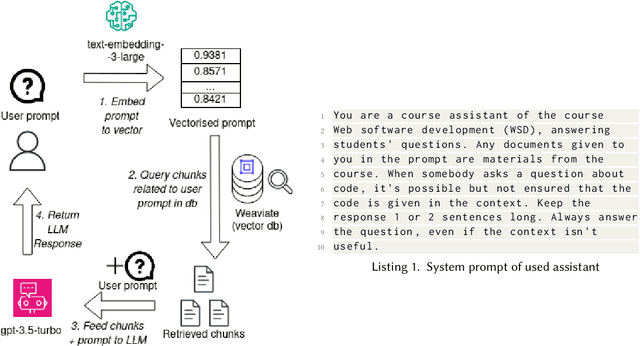

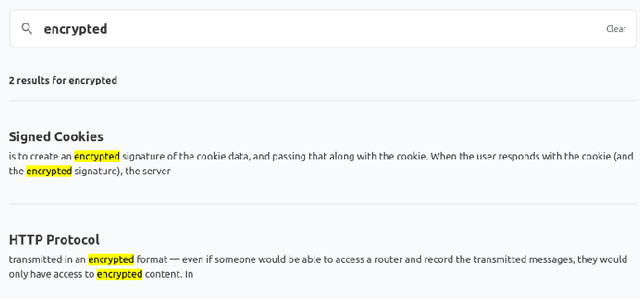
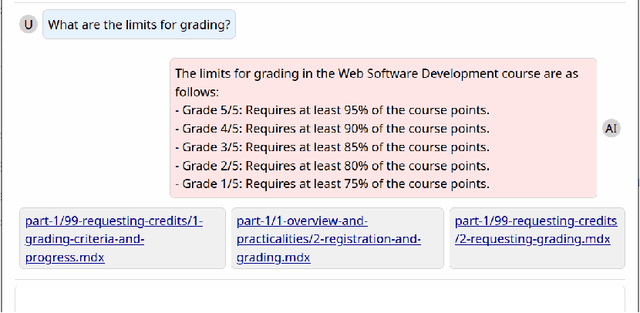
Abstract:Providing sufficient support for students requires substantial resources, especially considering the growing enrollment numbers. Students need help in a variety of tasks, ranging from information-seeking to requiring support with course assignments. To explore the utility of recent large language models (LLMs) as a support mechanism, we developed an LLM-powered AI chatbot that augments the answers that are produced with information from the course materials. To study the effect of the LLM-powered AI chatbot, we conducted a lab-based user study (N=14), in which the participants worked on tasks from a web software development course. The participants were divided into two groups, where one of the groups first had access to the chatbot and then to a more traditional search functionality, while another group started with the search functionality and was then given the chatbot. We assessed the participants' performance and perceptions towards the chatbot and the search functionality and explored their preferences towards the support functionalities. Our findings highlight that both support mechanisms are seen as useful and that support mechanisms work well for specific tasks, while less so for other tasks. We also observe that students tended to prefer the second support mechanism more, where students who were first given the chatbot tended to prefer the search functionality and vice versa.
Synthetic Students: A Comparative Study of Bug Distribution Between Large Language Models and Computing Students
Oct 11, 2024



Abstract:Large language models (LLMs) present an exciting opportunity for generating synthetic classroom data. Such data could include code containing a typical distribution of errors, simulated student behaviour to address the cold start problem when developing education tools, and synthetic user data when access to authentic data is restricted due to privacy reasons. In this research paper, we conduct a comparative study examining the distribution of bugs generated by LLMs in contrast to those produced by computing students. Leveraging data from two previous large-scale analyses of student-generated bugs, we investigate whether LLMs can be coaxed to exhibit bug patterns that are similar to authentic student bugs when prompted to inject errors into code. The results suggest that unguided, LLMs do not generate plausible error distributions, and many of the generated errors are unlikely to be generated by real students. However, with guidance including descriptions of common errors and typical frequencies, LLMs can be shepherded to generate realistic distributions of errors in synthetic code.
Evaluating Language Models for Generating and Judging Programming Feedback
Jul 05, 2024

Abstract:The emergence of large language models (LLMs) has transformed research and practice in a wide range of domains. Within the computing education research (CER) domain, LLMs have received plenty of attention especially in the context of learning programming. Much of the work on LLMs in CER has however focused on applying and evaluating proprietary models. In this article, we evaluate the efficiency of open-source LLMs in generating high-quality feedback for programming assignments, and in judging the quality of the programming feedback, contrasting the results against proprietary models. Our evaluations on a dataset of students' submissions to Python introductory programming exercises suggest that the state-of-the-art open-source LLMs (Meta's Llama3) are almost on-par with proprietary models (GPT-4o) in both the generation and assessment of programming feedback. We further demonstrate the efficiency of smaller LLMs in the tasks, and highlight that there are a wide range of LLMs that are accessible even for free for educators and practitioners.
Open Source Language Models Can Provide Feedback: Evaluating LLMs' Ability to Help Students Using GPT-4-As-A-Judge
May 08, 2024Abstract:Large language models (LLMs) have shown great potential for the automatic generation of feedback in a wide range of computing contexts. However, concerns have been voiced around the privacy and ethical implications of sending student work to proprietary models. This has sparked considerable interest in the use of open source LLMs in education, but the quality of the feedback that such open models can produce remains understudied. This is a concern as providing flawed or misleading generated feedback could be detrimental to student learning. Inspired by recent work that has utilised very powerful LLMs, such as GPT-4, to evaluate the outputs produced by less powerful models, we conduct an automated analysis of the quality of the feedback produced by several open source models using a dataset from an introductory programming course. First, we investigate the viability of employing GPT-4 as an automated evaluator by comparing its evaluations with those of a human expert. We observe that GPT-4 demonstrates a bias toward positively rating feedback while exhibiting moderate agreement with human raters, showcasing its potential as a feedback evaluator. Second, we explore the quality of feedback generated by several leading open-source LLMs by using GPT-4 to evaluate the feedback. We find that some models offer competitive performance with popular proprietary LLMs, such as ChatGPT, indicating opportunities for their responsible use in educational settings.
Benchmarking Educational Program Repair
May 08, 2024Abstract:The emergence of large language models (LLMs) has sparked enormous interest due to their potential application across a range of educational tasks. For example, recent work in programming education has used LLMs to generate learning resources, improve error messages, and provide feedback on code. However, one factor that limits progress within the field is that much of the research uses bespoke datasets and different evaluation metrics, making direct comparisons between results unreliable. Thus, there is a pressing need for standardization and benchmarks that facilitate the equitable comparison of competing approaches. One task where LLMs show great promise is program repair, which can be used to provide debugging support and next-step hints to students. In this article, we propose a novel educational program repair benchmark. We curate two high-quality publicly available programming datasets, present a unified evaluation procedure introducing a novel evaluation metric rouge@k for approximating the quality of repairs, and evaluate a set of five recent models to establish baseline performance.
"Like a Nesting Doll": Analyzing Recursion Analogies Generated by CS Students using Large Language Models
Mar 14, 2024


Abstract:Grasping complex computing concepts often poses a challenge for students who struggle to anchor these new ideas to familiar experiences and understandings. To help with this, a good analogy can bridge the gap between unfamiliar concepts and familiar ones, providing an engaging way to aid understanding. However, creating effective educational analogies is difficult even for experienced instructors. We investigate to what extent large language models (LLMs), specifically ChatGPT, can provide access to personally relevant analogies on demand. Focusing on recursion, a challenging threshold concept, we conducted an investigation analyzing the analogies generated by more than 350 first-year computing students. They were provided with a code snippet and tasked to generate their own recursion-based analogies using ChatGPT, optionally including personally relevant topics in their prompts. We observed a great deal of diversity in the analogies produced with student-prescribed topics, in contrast to the otherwise generic analogies, highlighting the value of student creativity when working with LLMs. Not only did students enjoy the activity and report an improved understanding of recursion, but they described more easily remembering analogies that were personally and culturally relevant.
Decoding Logic Errors: A Comparative Study on Bug Detection by Students and Large Language Models
Nov 27, 2023Abstract:Identifying and resolving logic errors can be one of the most frustrating challenges for novices programmers. Unlike syntax errors, for which a compiler or interpreter can issue a message, logic errors can be subtle. In certain conditions, buggy code may even exhibit correct behavior -- in other cases, the issue might be about how a problem statement has been interpreted. Such errors can be hard to spot when reading the code, and they can also at times be missed by automated tests. There is great educational potential in automatically detecting logic errors, especially when paired with suitable feedback for novices. Large language models (LLMs) have recently demonstrated surprising performance for a range of computing tasks, including generating and explaining code. These capabilities are closely linked to code syntax, which aligns with the next token prediction behavior of LLMs. On the other hand, logic errors relate to the runtime performance of code and thus may not be as well suited to analysis by LLMs. To explore this, we investigate the performance of two popular LLMs, GPT-3 and GPT-4, for detecting and providing a novice-friendly explanation of logic errors. We compare LLM performance with a large cohort of introductory computing students $(n=964)$ solving the same error detection task. Through a mixed-methods analysis of student and model responses, we observe significant improvement in logic error identification between the previous and current generation of LLMs, and find that both LLM generations significantly outperform students. We outline how such models could be integrated into computing education tools, and discuss their potential for supporting students when learning programming.
Can We Trust AI-Generated Educational Content? Comparative Analysis of Human and AI-Generated Learning Resources
Jul 03, 2023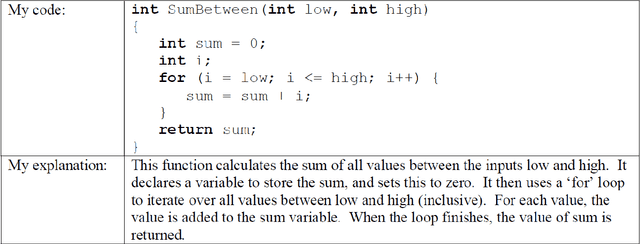
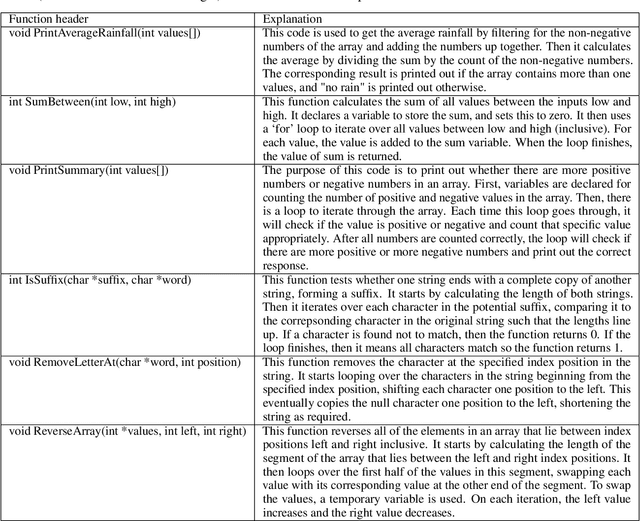
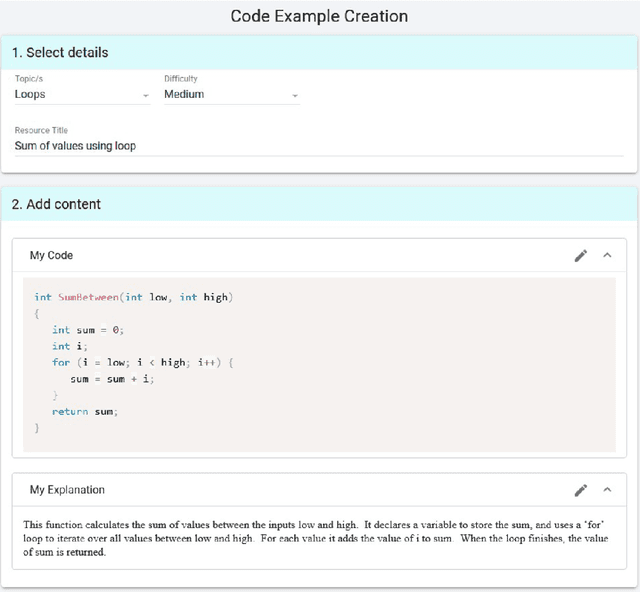

Abstract:As an increasing number of students move to online learning platforms that deliver personalized learning experiences, there is a great need for the production of high-quality educational content. Large language models (LLMs) appear to offer a promising solution to the rapid creation of learning materials at scale, reducing the burden on instructors. In this study, we investigated the potential for LLMs to produce learning resources in an introductory programming context, by comparing the quality of the resources generated by an LLM with those created by students as part of a learnersourcing activity. Using a blind evaluation, students rated the correctness and helpfulness of resources generated by AI and their peers, after both were initially provided with identical exemplars. Our results show that the quality of AI-generated resources, as perceived by students, is equivalent to the quality of resources generated by their peers. This suggests that AI-generated resources may serve as viable supplementary material in certain contexts. Resources generated by LLMs tend to closely mirror the given exemplars, whereas student-generated resources exhibit greater variety in terms of content length and specific syntax features used. The study highlights the need for further research exploring different types of learning resources and a broader range of subject areas, and understanding the long-term impact of AI-generated resources on learning outcomes.
 Add to Chrome
Add to Chrome Add to Firefox
Add to Firefox Add to Edge
Add to Edge